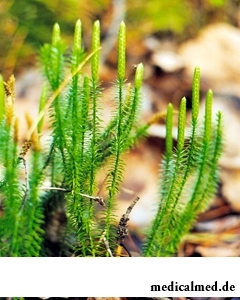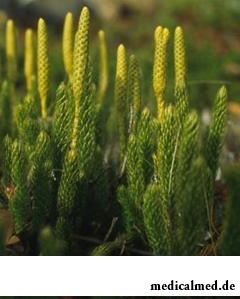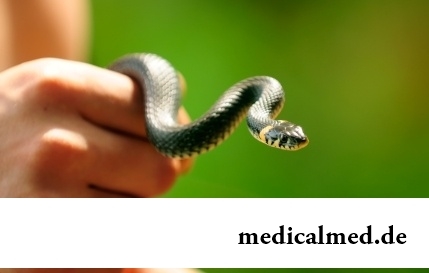





The club moss is club-shaped
Application instruction:
Useful properties of a club moss club-shaped
 Club moss club-shaped – an evergreen long-term sporous grass from family of the Club-moss family. Other known names of a grass: the club moss is medicinal, the zepka, a chicken pad, a box-thorn, is green, a rozvilnik, a pilochnik, a missel, a zelenukha, a kolotunnik, an earth or snake moss, a polzuchka.
Club moss club-shaped – an evergreen long-term sporous grass from family of the Club-moss family. Other known names of a grass: the club moss is medicinal, the zepka, a chicken pad, a box-thorn, is green, a rozvilnik, a pilochnik, a missel, a zelenukha, a kolotunnik, an earth or snake moss, a polzuchka.
In medicine apply disputes and an elevated part of a grass.
In disputes stearin, linoleic, palmitic, olein, myristic, geksadeinovy acids, active agents terpene, онацерин, ликоклаванол, sitosterol, sucrose are found. Disputes in July-August ripen, and them for further use in medicine begin preparation in August-September when escapes of a plant (strobiles) turn yellow. Disputes collect carefully not to scatter, it is better early in the morning or when air humidity is increased – so they do not scatter and are less scattered. Dry disputes only on air, in a shadow since after drying in furnaces they darken and slezhivatsya. Storage a dispute in time is not limited.
Stalks, leaves of a club moss club-shaped contain alkaloids, nicotine, flavonoids, acid dihydrocoffee therefore these parts of a club moss are poisonous. The grass can be prepared, since May and till fall.
Basic purpose of a club moss – treatment of diseases of generative organs, urinary, digestive systems, a respiratory organs, healing of wounds.
Use of a club moss club-shaped
 For processing of decubituses, elimination of an intertrigo at children, treatment of the becoming wet eczema, removals of a skin itch, healing of wounds use club moss disputes – as the drying powder. It is noticed that means well kills pains and cools the inflamed sites.
For processing of decubituses, elimination of an intertrigo at children, treatment of the becoming wet eczema, removals of a skin itch, healing of wounds use club moss disputes – as the drying powder. It is noticed that means well kills pains and cools the inflamed sites.
If there are bladder pains, recommend to host disputes inside, previously having pounded them with milk sugar 1:10. Three accept means р / day, on a knife tip. Two р / host day the ground plant disputes at diarrhea, gripes, rheumatism.
The grass of a club moss club-shaped has anticonvulsant, soothing, diuretic effect.
For removal of spastic stomach aches prepare tea: one teaspoon is filled in by 500 ml of boiled water, without cooling, filter.
Such broth possesses diuretic action: 1 tablespoon of the crushed club moss stalks is the share of 500 ml of water. The grass is made by 6-8 minutes on weak fire, two hours insist, filter. Drink infusion 3-4 р / day on a tablespoon.
At stones in a bladder, kidneys, acute cystitis cook such broth: two spoons of dining rooms a dispute of a club moss club-shaped fill in 500 ml of water, boil 10 minutes, draw hour, filter. Drink medicine on a tablespoon each hour.
At diseases of a respiratory organs one tablespoon of raw materials is made by 250 ml of water, boil under a cover 10-12 minutes, two hours insist, filter. Drink infusion 4 р / day on a tablespoon.
At gastrointestinal diseases drink 4 р / day 0,5 glasses of such broth: two spoons tea the dry crushed grass fill in 500 ml of boiled cold water, 4-5ch insist, filter.
At cholecystitis, hepatitis accept 4 р / day 0,5 glasses of such means: one teaspoon a dispute of a club moss club-shaped is filled in by 250 ml of water of cold, 8 hours insist, filter.
Tincture on a club moss can be applied in complex treatment of an alcoholism – to strengthening of an emetic reflex.
Disputes of a club moss club-shaped are a part of many homeopathic medicines used at bladder spasms, gripes, rheumatism, bronchitis, hemorrhoids, increase in a liver, vascular spasms, nervous breakdowns, fever.
Contraindications of a club moss club-shaped
It is not recommended to use a club moss club-shaped for treatment without medical recommendation and appointment because of its virulence. In a large number of means on the basis of a club moss cause severe poisoning.
In the aspiration to pull out the patient, doctors often go too far. So, for example, a certain Charles Janszen during the period from 1954 to 1994 endured more than 900 operations on removal of new growths.

Statistically, pathologies of a thyroid gland in the world more than 500 million people have. Failures in work of this body conduct to is heavy...
Section: Articles about health
Several decades ago the basil (the district khan, реан, Reagan) was considered as a part of the Caucasian or east cuisine, but today it strongly took the place on tables of Russians. Greens of this plant possess a strong, pleasant smell and specific fresh taste, because of to...
Section: Articles about health
The phenomenon of improvement of a condition of the patients at administration of drugs who are not containing active agents, so-called effect of placebo is known long ago. At the end of the 18th century the American doctor Perkins began to treat people the "miracle" sticks made of alloy of steel and brass. Was for several minutes to press such subject enough to a sore point that it became much easier for the patient. Having suspected Perkins of charlatanism, his colleagues tried to repeat "miracle" by means of sticks, steles...
Section: Articles about health
The endocrine system carries out in a human body extremely important role, practically all processes of life activity регулируютс...
Section: Articles about health
Statistically cystitis 25-30% of women up to 40 years have. With age this indicator raises, besides many do not get to statistics because do not see a doctor. The most sad that after the regular visits to doctors, long reception of antibiotics...
Section: Articles about health
Reactive pancreatitis - the disease which is characterized by inflammatory process in a pancreas which arises most often because of excess activity of digestive enzymes. It − the emergency state which treatment has to take place in surgical department under control of doctors. The acute inflammation of gland can become the reason of its transition to a chronic form, and also development is purulent - necrotic pancreatitis which the extensive necrosis of fabrics can follow. Zabolev...
Section: Articles about health
From the failure of work of immune system which is shown in the form of an allergy, statistically, more than 40% of the population of the globe suffer. In большинс...
Section: Articles about health
Today about 30 diseases, sexually transmitted are known. Wide circulation of these illnesses is extremely promoted by the dual attitude towards them: on the one hand, most of people know about "shameful" diseases and not a stirrup very little...
Section: Articles about health
Physical activity is necessary for normal functioning of a human body. At a lack of the movement joints cease to function, muscles atrophy, cardiovascular activity is broken and the metabolism worsens. The modern city rhythm of life does not provide the person with an adequate exercise stress, additional - sport is necessary. Tedious tasks the huge number of the people having those or ин exists sport not all to liking, but also...
Section: Articles about health
The naturopathy sometimes moves as the new direction of medicine, something like fashionable hobby, and there is nothing farther from the truth....
Section: Articles about health
Tea is loved and use almost everything. This drink has tonic properties, contains the tannins capable to suppress activity of causative organisms. Recently great popularity was gained by teas with vegetable additives. Лечеб...
Section: Articles about health
The technique of acupuncture (acupuncture) is used in the medical purposes more than three and a half millennia. It is eurysynusic and recognized as official medicine in the majority of the developed countries of the world. Influence by fine needles on so-called points of acupuncture contributes to normalization of a metabolism and hormonal background, activates protective forces of an organism, has anesthetic and antiinflammatory effect, stabilizes a condition of mentality....
Section: Articles about health
Health and attractiveness - eternal values, pursuing which people often use the most unusual ingredients and technicians...
Section: Articles about health
Some people consider what for medicine of the 21st century of secrets in the field of health of the person almost does not exist. It absolutely not so. The more answers scientists receive, the more the most difficult questions are raised for them by life. Besides, there are diseases, not объясн in any way...
Section: Articles about health
During foot walks blood moves on vessels more actively and one and all bodies are supplied with a large amount of oxygen. It affects the state of health of the person very positively....
Section: Slideshow
According to World Health Organization, every third inhabitant of Earth has excess weight, and every tenth suffers ожирен...
Section: Articles about health
The fatigue, sleep debt, disturbances of food, bad mood, vagaries of the weather – all these circumstances badly affect our appearance. Especially the person suffers: skin becomes flabby, loses healthy color, becomes covered by wrinkles, zones of hypostases and t appear...
Section: Articles about health
Residents of big cities quite often have a disease which is known as the syndrome of chronic fatigue (SCF) today. This illness affects the people belonging to various social and demographic groups and living on all continents. Most of all SHU are subject women aged from 25 up to 45 years. Statistically, the number of cases fluctuates in the different countries from 10 to 37 people on 100 thousand, but specialists believe that these figures are significantly underestimated as people, страдающ...
Section: Articles about health
Each of us repeatedly noticed that the people having the same passport age are sometimes not similar on one-years at all. One...
Section: Articles about health
Olive oil – the product capable to make a powerful contribution to health of the person if it includes it in the diet. The rich vitamin composition of oil does it by a product number one from many diseases including from deadly. Only two tablespoons...
Section: Articles about health
Smack in a mouth can arise in the natural way – as a result of lack of morning hygiene or reception of the corresponding food. However in certain cases its existence is a sign of certain pathologies, and allows to reveal an illness at an early stage. Depending on character of aftertaste – acid, salty, bitter, sweet – distinguish also diseases which accompany it....
Section: Articles about health
Good appetite was always considered as a sign of good health. The correct operation of the mechanism which is responsible for the need for nutritious...
Section: Articles about health
Dietary supplements (dietary supplements) for the last decades were so thoroughly included into our life that, apparently, it is already impossible to find the person who at least once did not try them. At the same time, most of our compatriots have a vague idea about...
Section: Articles about health
The Genetically Modified Organisms (GMO) are plants or animals (as a rule, agricultural) to whose genotype purposeful changes were made. Opposition of supporters and opponents of inclusion of such organisms in foodstuff always was very acute. Not only scientists and dietitians, but also a large number of the people who are not specialists in this question are involved in active disputes today....
Section: Articles about health
The trophic ulcer is not an independent disease. This heavy complication arising owing to a thermal injury (a burn...
Section: Articles about health
The phenomenon of the panic attack is known long ago, but the reasons of its emergence still are up to the end not found out. It is established that more than 30% of people at least once in life become the victims of very unpleasant phenomenon: without everyones on that the reasons they have a feeling of horror, with...
Section: Articles about health
All diseases from nerves – in this joke a big element of truth, are said by doctors. Constant stresses lead to decrease in protective forces of an organism, and it becomes vulnerable for a set of diseases. It is wrong to think that the stress is a problem of the present. Life of people and hundred, and one thousand years ago also abounded with problems therefore need of a relaxation understood in ancient times – to some techniques more than one thousand years. The person needs knowledge of how it is possible to relax, this knowledge пригод...
Section: Articles about health
